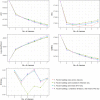Exploring Sensory Subgroups in Typical Development and Autism Spectrum Development Using Factor Mixture Modelling
- PMID: 34499275
- PMCID: PMC9349169
- DOI: 10.1007/s10803-021-05256-6
Exploring Sensory Subgroups in Typical Development and Autism Spectrum Development Using Factor Mixture Modelling
Abstract
This study uses factor mixture modelling of the Short Sensory Profile (SSP) at two time points to describe subgroups of young autistic and typically-developing children. This approach allows separate SSP subscales to influence overall SSP performance differentially across subgroups. Three subgroups were described, one including almost all typically-developing participants plus many autistic participants. SSP performance of a second, largely-autistic subgroup was predominantly shaped by a subscale indexing behaviours of low energy/weakness. Finally, the third subgroup, again largely autistic, contained participants with low (or more "atypical") SSP scores across most subscales. In this subgroup, autistic participants exhibited large P1 amplitudes to loud sounds. Autistic participants in subgroups with more atypical SSP scores had higher anxiety and more sleep disturbances.
Keywords: Auditory P1; Auditory event-related potentials (ERPs); Autism; Factor mixture modelling; Heterogeneity; Sensory processing.
© 2021. The Author(s).
Conflict of interest statement
The authors have no relevant conflicts of interest to declare.
Figures






References
-
- Achenbach TM, Rescorla LA. Manual for the ASEBA preschool forms and profiles. University of Vermont; 2000.
-
- American Psychiatric Association. (2013). Neurodevelopmental disorders. In Diagnostic and statistical manual of mental disorders (5th ed.). 10.1176/appi.books.9780890425596.dsm01.
-
- Aoki S, Kagitani-Shimono K, Matsuzaki J, Hanaie R, Nakanishi M, Tominaga K, Taniike M, et al. Lesser suppression of response to bright visual stimuli and visual abnormality in children with autism spectrum disorder: A magnetoencephalographic study. Journal of Neurodevelopmental Disorders. 2019;11:9. doi: 10.1186/s11689-019-9266-0. - DOI - PMC - PubMed

